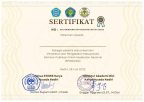YOUTH EMPOWERMENT IN OVERCOMING DYMENORHEA WITH YOGA EXERCISE
OF THE NAHDLATUL ULAMA WOMEN STUDENT ASSOCIATION (PPNU) DS. KALI WUNGU, KEC./KAB. JOMBANG
Keywords:
Counselling, Yoga Exercise, DysmenorrheaAbstract
Adolescents who experience dysmenorrhea often do not attend school or cannot follow lessons well. Alternative treatment for dysmenorrhea pain is needed as a form of treatment that is safer, more practical, can be done by teenagers themselves. This community service activity aims to provide knowledge and skills about yoga exercise in the context of managing dysmenorrhea pain. The form of this community service activity is in the form of providing education/counseling about dysmenorrhea and how to treat it, yoga exercise training and the application of yoga exercise directly on dysmenorrhea conditions. The activity was carried out in Kaliwungu Village, Jombang District/Regency on January 26 to March 5, 2022 with the target of youth groups from the Nahdlatul Ulama Women's Student Association (IPPNU) Kaliwungu a total of 23 teenagers. The extension method is lecture and question and answer. The training was carried out using demonstration methods and direct practice of yoga exercises. Followed by the application of yoga exercises directly on the first day of feeling the pain of dysmenorrhea until the third day. Analysis of the impact of knowledge was measured by giving pre and post test questionnaires, the ability of yoga exercise with a checklist and the impact of yoga exercise on reducing dysmenorrhea pain was measured by data collection sheets of pre and post yoga exercise pain scales. The results of the analysis of the impact of community service activities showed that 74% of participants' knowledge after counseling was in the good category from the previous 78% in the poor category. The participants' yoga exercise ability after training was 52% in the good category, increasing from 100% in the less category. 62% of participants' dysmenorrhea pain levels were in the mild category, from the previous 57% in the moderate category and 3% in the severe category. It can be concluded that this community service activity is able to contribute to the reduction of the participants' dysmenorrhea pain.
Downloads
Published
Issue
Section
License
Copyright (c) 2022 Seminar Publikasi Ilmiah Kesehatan Nasional

This work is licensed under a Creative Commons Attribution 4.0 International License.







